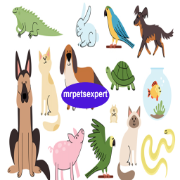Treatment of glaucoma in cats
Glaucoma is an eye illness that influences felines as well as people. It causes a difficult expansion in tension inside the eye and can prompt visual impairment. With early veterinary treatment, including eye drops to diminish pressure, felines can generally hold their vision and live serenely with this infection Let's start to read Treatment of glaucoma in cats.
Reasons for Glaucoma in Felines
Glaucoma in felines can be ordered into essential and optional structures:
1. Essential Glaucoma:
Essential glaucoma is accepted to have a hereditary inclination, with specific varieties being more defenseless, like Siamese, Burmese, and Persian felines. The fundamental reason includes a glitch in the eye's waste framework, prompting weakened liquid outpouring and ensuing height of intraocular pressure.
2. Optional Glaucoma:
Optional glaucoma happens because of fundamental visual or foundational conditions, including:
Uveitis:
Irritation of the uvea (the center layer of the eye) can prompt auxiliary glaucoma.
Focal point Luxation:
Uprooting the focal point inside the eye can discourage the seepage point, causing an ascent in intraocular pressure.
Growths:
Intraocular growths or neoplasms can slow down typical liquid seepage, bringing about auxiliary glaucoma.
Injury:
Extreme eye wounds or injuries can disturb the eye's physical designs, including the seepage framework, prompting auxiliary glaucoma.
Side Effects of Glaucoma in Felines
Perceiving the indications of glaucoma in felines is pivotal for early location and mediation. Normal side effects include:
Redness:
The whites of the impacted eye might seem red or ragged looking because of expanded vascular blockage.
Darkness:
Shadiness or dimness inside the cornea can happen because of corneal edema optional to raised intraocular pressure.
Expanded Student:
The understudy of the impacted eye might seem widened and less receptive to light upgrades.
Squinting:
Felines with glaucoma frequently show squinting or fractional conclusions of the impacted eye because of uneasiness.
Scouring or Pawing at the Eye:
Felines might show ways of behaving characteristic of visual uneasiness, like scouring or pawing at the impacted eye.
Diminished Hunger:
In serious cases, felines might encounter a decline in craving or generally laziness.
Vision Misfortune:
Moderate glaucoma can prompt irreversible vision misfortune whenever left untreated.
Conclusion of Glaucoma in Felines
Diagnosing glaucoma in felines requires a careful ophthalmic assessment by a veterinarian or veterinary ophthalmologist. Demonstrative methodology might include:
1. Intraocular Strain Estimation:
Estimation of intraocular pressure (IOP) utilizing a tonometer is an essential symptomatic instrument for evaluating glaucoma. Raised IOP levels over the ordinary reach (commonly 15-25 mmHg) are demonstrative of glaucoma.
2. Ophthalmic Assessment:
A thorough eye assessment includes surveying the front and back sections of the eye, including the cornea, focal point, iris, retina, and optic nerve. Signs like corneal edema, iris staining, focal point uprooting, and optic nerve measuring might be demonstrative of glaucoma.
3. Gonioscopy:
Gonioscopy permits perception of the seepage point and appraisal of its patency. It separates between essential and optional glaucoma and guides treatment choices.
4. Extra Indicative Tests:
Extra tests, like visual ultrasound, electroretinography (ERG), and imaging modalities (e.g., optical soundness tomography), might be performed to assess the degree of visual harm and evaluate the anticipation.
Treatment Choices for Glaucoma in Felines
The administration of glaucoma in felines means to lighten visual distress, diminish intraocular tension, and safeguard vision whenever the situation allows. Treatment choices include:
1. Clinical Administration:
Skin Prescriptions:
Prostaglandin analogs, beta-blockers, carbonic anhydrase inhibitors, and miotics are regularly used to bring down intraocular strain by either lessening fluid humor creation or improving its surge.
Oral Prescriptions:
Fundamental drugs, for example, carbonic anhydrase inhibitors or osmotic specialists might be endorsed in instances of recalcitrant glaucoma.
Torment The executives:
Nonsteroidal mitigating drugs (NSAIDs) or narcotics might be utilized to ease visual agony and distress.
2. Careful Mediations:
Laser Treatment:
Laser methodologies like laser cyclophotocoagulation (CPC) or laser iridotomy can assist with working on the fluid surge and diminish intraocular pressure.
Sifting A medical procedure:
Careful methods, for example, trabeculectomy or shunt implantation might be performed to make another waste pathway for watery humor.
Enucleation:
In instances of end-stage or difficult glaucoma, careful expulsion of the impacted eye (enucleation) might be important to assuage distress and forestall confusion.
3. Reciprocal Treatments:
Needle therapy:
A few pet people investigate needle therapy as a reciprocal treatment to mitigate torment and irritation related to glaucoma.
Dietary Enhancements:
Certain cell reinforcements or nutraceuticals might be useful in supporting visual well-being and diminishing oxidative pressure.
Visualization and Complexities
The guess for felines with glaucoma relies upon different variables, including the basic reason, the seriousness of intraocular pressure height, length of the condition, and reaction to treatment. While early location and mediation can further develop results, glaucoma can prompt irreversible vision misfortune and entanglements, for example,
Optic Nerve Harm:
Delayed height of intraocular strain can bring about irreversible harm to the optic nerve, prompting long-lasting vision debilitation.
Auxiliary Intricacies:
Untreated or inadequately overseen glaucoma can incline felines toward optional visual complexities like corneal ulceration, focal point luxation, retinal separation, and phthisis bulbi (shrinkage of the eyeball).
Reciprocal Contribution:
Felines determined to have glaucoma in one eye are in danger of fostering the condition in the contralateral eye over the long haul, highlighting the significance of standard checking and preventive measures.
Preventive Measures and Long-Haul Care
While essential glaucoma can't be forestalled because of its hereditary nature, certain preventive measures can assist with lessening the gamble of auxiliary glaucoma and advance generally speaking visual well-being:
Normal Veterinary Assessments:
Routine eye assessments by a veterinarian or veterinary ophthalmologist can support early location of visual circumstances, permitting brief intercession and the executives.


















No comments:
Post a Comment